With “Core Part” guitarist Oleg Dergilev presents major guitar works by Mexican composer Manuel Maria Ponce. All compositions being performed were selected by the interpret.
Programm
Manuel Maria Ponce (1882 – 1948)
- “24 Préludes” (1920s)
- Suite en la Mineur (1929)
Preludio – Allemande – Sarabande – Gavotte – Gigue - Sonata III (1927)
Allegro moderato – Chanson – Allegro non troppo - Variations sur “Folia de España” et Fugue (1929)
Manuel Maria Ponce Cuellar was born in a small mining town called Fresnillo on 8th December 1882 to become an outstanding composer appreciated by every guitarist. His guitar works play a significant role in guitar repertoire, although he wasn’t a guitarist himself. Now let us start from the beginning.
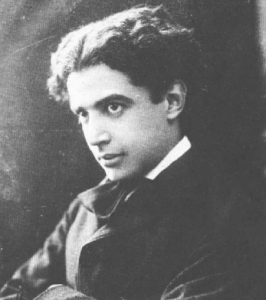 Ponce was the 12th child in his family. His parents didn’t get any particular musical education though his mother motivated some of the children to study the piano. However Ponce was considered to the musical prodigy. During his teenage years, he played the organ at the Church of San Diego in Aguascalientes and wrote several small keyboard pieces. In 1900, he moved to Mexico City and entered the National Conservatory of Music where he studied piano. First piano works were written, among them, the brilliant Estudio de concierto № 3, as well as his first writing for the strings – the Andante for string quartet.
Ponce was the 12th child in his family. His parents didn’t get any particular musical education though his mother motivated some of the children to study the piano. However Ponce was considered to the musical prodigy. During his teenage years, he played the organ at the Church of San Diego in Aguascalientes and wrote several small keyboard pieces. In 1900, he moved to Mexico City and entered the National Conservatory of Music where he studied piano. First piano works were written, among them, the brilliant Estudio de concierto № 3, as well as his first writing for the strings – the Andante for string quartet.
Four years later, in 1904, Ponce moved to Europe for the first time. Due to the recommendation of his former harmony professor Gabrielli, Ponce went to Bologna’s Liceo Musicale where he contacted organist, composer and director of the school Marco Enrico Bossi. Here he received his fundamental knowledge in harmony, counterpoint and orchestration. At the same time he got the opportunity to study piano with Martin Fischer in Berlin but, his financial situation made Ponce return back to Mexico. This short stay in Europe strongly improved his composition and piano techniques.
Meanwhile his popularity in Latin America grew. At only 25 years of age Ponce replaced former music director of the National Conservatory of Music Ricardo Castro after his death, teaches piano and music history. In 1915 Ponce left to Havana accompanied by a violinist Pedro Valdez Fraga and a poet Luis Gonzaga Urbina. Now it was the turn of cuban music to influence his new works, such as “Suite Cubana” (1915), “Elegia de la Ausencia” (1915) and three elaborate Cuban Rhapsodies for piano. 1917 Ponce turned back to Mexico City for the next 8 years, where he continued teaching and conducting the Orquestra Sinfónica Nacional, performing works by Mendelssohn, Liszt, Grieg, Glazunov, Wagner, Schubert and Tchaikovsky.
 The music of European post-romanticism that pervaded Mexico, was one of the major influences, that shaped Ponce’s music over the course of his life. Another one was his interest in folk music, which resulted not only in his involvement as a pioneer of Nationalism in Mexican music but also in a large number of compositions with Cuban and Spanish musical flavor. But there was another important factor that influenced his works.
The music of European post-romanticism that pervaded Mexico, was one of the major influences, that shaped Ponce’s music over the course of his life. Another one was his interest in folk music, which resulted not only in his involvement as a pioneer of Nationalism in Mexican music but also in a large number of compositions with Cuban and Spanish musical flavor. But there was another important factor that influenced his works.
At age 42, Ponce decided to update his compositional technique. He went to Paris for this purpose and resided there from 1925 to 1933. In addition to studies with Paul Dukas, who was impressed by Ponce’s dedication to music, at the Ecole Normale de Musique, Ponce came in close contact with the music of some of the greatest composers of the twentieth century, including Stravinsky, Debussy, Ravel, Satie, Milhaud, Honegger, Schoenberg, Berg, Hindemith, de Falla, Villa-Lobos, Varese, and many others. As a result, he absorbed more explicitly neoclassical and impressionistic tendencies into his style and the Paris period proved to be the most productive in his life. And this was especially the case in the area of guitar.
 In 1923 Ponce met a legendary spanish guitarist Andres Segovia and his artistic creativity line moved into another direction. Little did he know that limb would grow to be one of his most prolific, both in terms of quality and quantity. In addition, it would contribute enormously to the literature of the guitar. Soon after Segovia and Ponce met they became good friends. In his letters to Ponce, Segovia always expressed his respect and admiration of his composer talent. For Segovia Ponce had crucial significance:
In 1923 Ponce met a legendary spanish guitarist Andres Segovia and his artistic creativity line moved into another direction. Little did he know that limb would grow to be one of his most prolific, both in terms of quality and quantity. In addition, it would contribute enormously to the literature of the guitar. Soon after Segovia and Ponce met they became good friends. In his letters to Ponce, Segovia always expressed his respect and admiration of his composer talent. For Segovia Ponce had crucial significance:
“Thanks to him […] the guitar was saved from the music written exclusively by guitarists”.
At the same time, Segovia was the most noticeable musician in performing Ponce’s guitar compositions. They became not only friends but also collaborators. Influenced by Segovia’s insistence and encouraging collaboration in Paris, Ponce wrote most of his numerous pieces for guitar.
Several works were written at Segovia’s request, which emulated a wide range of styles, from baroque to twentieth-century. In complicity with Segovia, Ponce permitted the publication of some of these pieces under the names of earlier composers. Among these was Suite en la Mineur.
It is not clear exactly when or where the idea was born to persuade Ponce to compose his modern counterfeits of baroque music. Aside of learning stylisation techniques at composer studies, probably it was Ponce’s outstanding talent for composing “in the style of” others, which Segovia discovered while encouraging Ponce to write for the guitar. 1920s Segovia and Kreisler had become friends, sharing advice and even impresarios. One tradition, related by Corazón Otero, has it that Segovia asked Ponce to compose the Suite en la Mineur as a joke on Kreisler, with whom he was to share a concert. Fearful that his Kreislereque prank would be obvious if the suite were attributed to Bach, Segovia persuaded Ponce to use Weiss (Silvius Leopold Weiss, 1687 – 1750) as a pseudonym. However, its success as a “Weiss Suite” was due to the public’s minimal knowledge of the baroque style rather than Ponce’s adroitness. Although Ponce used the baroque forms and techniques in a masterful manner, his character is evident in the obvious stylization of baroque devices, the use of romantically tinged lyricism, an idiomatic and sometimes virtuosic use of the guitar, and modern twists of harmony. In spite of its pretentious beginnings, this suite is one of the masterworks of 20th century guitar literature.
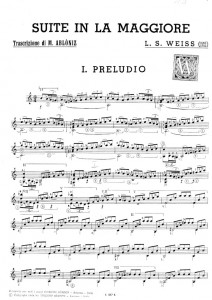 Closely modeled after the binary dances of the baroque suite, this work consists of five movements: Preludio, Allemande, Sarabande, Gavotte and Gigue. The Courante, usually after the Allemande in the baroque suite, is omitted. Although there are no thematic connections between the movements, the stylistic unity of the quasi-baroque method and the well balanced sequence of dances creates a dynamic and musically coherent whole. Segovia writes:
Closely modeled after the binary dances of the baroque suite, this work consists of five movements: Preludio, Allemande, Sarabande, Gavotte and Gigue. The Courante, usually after the Allemande in the baroque suite, is omitted. Although there are no thematic connections between the movements, the stylistic unity of the quasi-baroque method and the well balanced sequence of dances creates a dynamic and musically coherent whole. Segovia writes:
“I want to inform you of the success of Silvius Leopold Weiss. I am delighted with the triumph of this old master. The most informed critics and erudites have mentioned, in their reviews, many picturesque details of his life. And his resemblance to Bach has been well appreciated. Above all, the Prelude, the Allemande, and the Sarabande have been very much enjoyed. I am sure that Kreisler, who has written a Vivaldi concerto, will feel great sympathy for you”.
As a result Sylvius Leopold Weiss was an excellent choice for a pastiche and Suite en la Mineur of his authorship was printed by numerous publishers around the globe such as “Muzyka” or “Edizioni Berben”.
Although the relationship between Segovia and Ponce was very warm and respectful, Segovia was sometimes quite critical with the perception. Often he took liberties while editing Ponce’s music. It’s time to share with our precious auditory a story of “24 Preludes“.
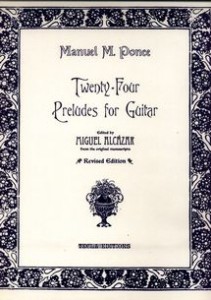
The initial plan was that Segovia and Ponce were going to co-author a guitar method. In response of Segovia’s admiration as a non-guitarist writing for guitar, Ponce wrote twenty-four preludes, one per each major and minor key. The preludes made a very traditional guitar sound, and yet Segovia complained that many were quite unidiomatic for the instrument – or simply “unplayable”. So it was chosen to publish these preludes in 4 volumes of six. Segovia changed several of them into more fingerboard-friendly keys. Only the first two volumes were published by Schott, six of Preludes were recorded by Segovia for Decca in 1952: No’s 6, 7, 9, 1, 3, 4 – notice the altered order! – and the other six – by Laurindo Almeida for Capitol Records in around 1960. John Williams did all 12 for the Westminster label. Throughout the 1960s/70s, various players recorded a few of the 12 Preludes, in varying combinations. Only in 1981 the rest of them appeared, thanks to guitarist Miguel Alcázar, who knew from Ponce’s personal documents that Ponce had actually written 24 preludes using all keys and who was determined to unearth them all. He succeeded in finding eleven of the remaining pieces, and, by craftily adapting another Ponce’s piece to fill the sole empty spot, edited, published, and recorded them. This music is a guitarist’s treasure-trove, which has only very recently come to light.
Variations sur “Folia d’España” et Fugue. Ponce’s production while in Paris also exhibited the growing influence of Spanish music on the composer – it was also probable that his close collaboration with Segovia brought him into intimate contact with that type of music. In 1928 Segovia made another request: Ponce has been asked to write a large set of variations:
“I would like you to make some brilliant variations on the theme of the Folias of Spain. […] If you don’t want to sign it we can ascribe it to Giuliani, of whom many things remain to be discovered”.
Although this letter implies that Segovia may have expected a pastiche in the early nineteenth-century style of Mauro Giuliani, Ponce, in 1929, created a powerful contemporary work comparable in technical demands to Bach’s famous Chaconne from the Partita No. II for solo violin.
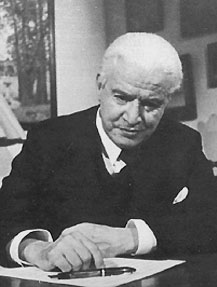 The folias originated in the Iberian peninsula, most likely Portugal, during the late fifteenth-century. The italian guitar romantic Giuliani as well as classic Sor wrote their shorter variations on Folia’s theme before, while Ponce’s work consists of twenty pages of single-stave notation: a theme, twenty variations and a fugue. According to correspondence between Segovia and Ponce, this work originally included a prelude: “Whenever I write I am tempted to explain why I haven’t offered the Prélude, Folias and Fugue to Schott”; and, in another letter concerning a performance at the Paris Opera during 1931: “I am thinking of including the Variations on the Folias, without the Prélude, but with the Fugue”. Once again, Segovia deemed a few of the many variations Ponce produced as “unsuitable, either to the guitar or to the work as an entity.” In fact, one of these unpublished variations was recorded by Segovia later in 1979 under the title of Postlude on Andrés Segovia […]. Back then, after recording in the late 1920s, he asked Ponce to rewrite the setting of the theme: the published score utilizes chromatic and nontraditional harmonies in the theme not heard on Segovia’s early recording. Thus, considering the cutting of the prelude, the new setting of the theme and the various unpublished variations, Segovia exercised considerable influence on the final form of this work.
The folias originated in the Iberian peninsula, most likely Portugal, during the late fifteenth-century. The italian guitar romantic Giuliani as well as classic Sor wrote their shorter variations on Folia’s theme before, while Ponce’s work consists of twenty pages of single-stave notation: a theme, twenty variations and a fugue. According to correspondence between Segovia and Ponce, this work originally included a prelude: “Whenever I write I am tempted to explain why I haven’t offered the Prélude, Folias and Fugue to Schott”; and, in another letter concerning a performance at the Paris Opera during 1931: “I am thinking of including the Variations on the Folias, without the Prélude, but with the Fugue”. Once again, Segovia deemed a few of the many variations Ponce produced as “unsuitable, either to the guitar or to the work as an entity.” In fact, one of these unpublished variations was recorded by Segovia later in 1979 under the title of Postlude on Andrés Segovia […]. Back then, after recording in the late 1920s, he asked Ponce to rewrite the setting of the theme: the published score utilizes chromatic and nontraditional harmonies in the theme not heard on Segovia’s early recording. Thus, considering the cutting of the prelude, the new setting of the theme and the various unpublished variations, Segovia exercised considerable influence on the final form of this work.
The general style of variations is an mix of neoclassical treatment of form, neoromantic lyricism and expression, and a mixture of neoromantic and impressionistic harmonies. Each of them derive from various combinations of the melodic, rhythmic or harmonic traits of the theme. There is marked contrast between variations in terms of tempo, meter, texture and melodic figuration; thus, each variation has a distinct character of its own. Although somewhat academic, Fugue is a self-contained entity, a pleasant and well-conceived work, showing Ponce’s excellent control of dramatic tension and formal organization.
Speaking of Ponce’s Sonatas, the three most famous are without a doubt Sonata classica, Sonata romantica and Sonata III, though there have always been questions on the numerical order of them. Due to clear chronological style order or due to their order of appearance in printed media, Sonata III is usually considered as a logical completion of this combo, after classical and romantic stylizations representing a music language of Ponce’s modernity. However this is not entirely true. The first major work to be composed in Paris was the important Theme Varié et Finale, a virtuosic work based on an original theme, written in 1926. This was followed by the Sonata III (1927). It is possible that the second sonata was destroyed, along with many original manuscripts, during a fire in Segovia’s home in Barcelona. There has been mention of a sonata in A minor in the early letters written from Segovia to Ponce. According to Miguel Alcazar in “Obra Completa para Guitarra de Manuel M. Ponce”, these letters are dated in 1926, before Sonata III was composed and after Sonata Mexicana, which is also known as Sonata I. Sonata classica and Sonata romantica were written afterwards in 1928.
In Sonata III, Ponce applied the compositional techniques he so wanted to learn. It consists of 3 parts that have an easy structure of a “sonata form”, a three-part song an a rondo, and shows Ponce utilizing a modern harmonic language, including impressionistic devices and strong contrapuntal textures. Ponce’s mature style was modern but not avant-garde. It was the result of continuous evolution firmly based on traditional musical values, not a break from the past, as was the case in Schoenberg’s atonal music. Based on tonality, Ponce’s musical idiom incorporated his romantic nature as well as his nationalistic inclinations, always being very strong.
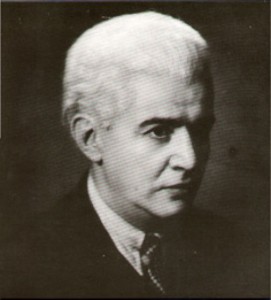 Ponce returned to Mexico City and lived here from 1933 until his death in 1948. Although suffering from poor health, he was amazingly productive. In addition to composition, he dedicated himself to many other activities. From 1933 to 1946, he taught Piano, Music History, Pedagogy, Esthetics, Folk Music, and even Rhythmic Gymnastics at the Conservatorio Nacional, 1943 he was named the chair of Folklore. During this final period, there were numerous successful premieres and performances of Ponce’s orchestral music. On July 4th 1947, a composer Carlos Chavez organized a festival devoted to Ponce’s works. During the festival, Andres Segovia gave the Mexican premiere of the Concierto del Sur. That year, Ponce was also awarded the prestigious “Premio National de Artes y Ciencias” (National Prize of Arts and Sciences), which included a diploma and a cash prize of 20,000 pesos. But Ponce’s health quickly deteriorated. On April 24, 1948, he died of uremic poisoning at the age of sixty-six.
Ponce returned to Mexico City and lived here from 1933 until his death in 1948. Although suffering from poor health, he was amazingly productive. In addition to composition, he dedicated himself to many other activities. From 1933 to 1946, he taught Piano, Music History, Pedagogy, Esthetics, Folk Music, and even Rhythmic Gymnastics at the Conservatorio Nacional, 1943 he was named the chair of Folklore. During this final period, there were numerous successful premieres and performances of Ponce’s orchestral music. On July 4th 1947, a composer Carlos Chavez organized a festival devoted to Ponce’s works. During the festival, Andres Segovia gave the Mexican premiere of the Concierto del Sur. That year, Ponce was also awarded the prestigious “Premio National de Artes y Ciencias” (National Prize of Arts and Sciences), which included a diploma and a cash prize of 20,000 pesos. But Ponce’s health quickly deteriorated. On April 24, 1948, he died of uremic poisoning at the age of sixty-six.
Manuel Ponce sacrificed his life to music. He also single-handedly began the nationalistic movement in his native Mexico, forever establishing his place in his country’s history. Everyone who met him commented favorably on some aspect of his character: his great kindness, infinite modesty, vast culture, and strong will to fulfill his vocation. Although he had contact with great artistic figures, he had only a few close friends, including Urbina, Segovia, Dukas, Marc Pincherle, Carlos Gonzalez Pena, and Antonio Brambila. And due to one of them, he also helped establish a repertoire for an instrument desperately in need of one: the guitar. In a letter written to Ponce’s widow, Segovia says:
“I do not need to express to you the pain which I will carry all my life from Manuel’s having preceded me on the road to Eternity. For me, Manuel was the ideal Friend, Teacher, and Brother. Not to have him in this world as a spiritual support, as a confidant and as a guide […] is deeply painful to me”.
 Born in 1986 in Leningrad Oleg Dergilev acquired his initial musical and instrumental skills through guitar lessons with Alexey Khorev (Алексей Алексеевич Хорев, 1951 – 2011). In 2003, Dergilev moved to Vienna to do further studies under the guidance of professor Walter Würdinger at the University of Music and Performing Arts, where he graduated from seven years later with honours. So far, guitarist Dergilev has won over 40 guitar competitions. Currently he performs regularly at the Vienna State Opera being involved in opera productions and graduates sound engineering faculty at the University of Music.
Born in 1986 in Leningrad Oleg Dergilev acquired his initial musical and instrumental skills through guitar lessons with Alexey Khorev (Алексей Алексеевич Хорев, 1951 – 2011). In 2003, Dergilev moved to Vienna to do further studies under the guidance of professor Walter Würdinger at the University of Music and Performing Arts, where he graduated from seven years later with honours. So far, guitarist Dergilev has won over 40 guitar competitions. Currently he performs regularly at the Vienna State Opera being involved in opera productions and graduates sound engineering faculty at the University of Music.
Dergilev has appeared in concert performing solo and chamber music programs all over Europe including Austria, Germany, Italy, Portugal, Russia and Ukraine.
Audio embedded in page are excerpts from the concert recording at Christuskirche in Vienna, Austria in 2011.